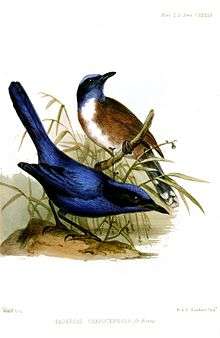Emperor fairywren
The emperor fairywren (Malurus cyanocephalus) is a species of bird in the Australasian wren family, Maluridae. It is found in New Guinea in its natural habitat of subtropical or tropical moist lowland forests.
| Emperor fairywren | |
|---|---|
.jpg) | |
| Illustration by John Gould and W. Hart | |
| Scientific classification | |
| Kingdom: | Animalia |
| Phylum: | Chordata |
| Class: | Aves |
| Order: | Passeriformes |
| Family: | Maluridae |
| Genus: | Malurus |
| Species: | M. cyanocephalus |
| Binomial name | |
| Malurus cyanocephalus | |
| Synonyms | |
| |
It is the largest species of fairywren. It is highly sexually dimorphic. Males have a blue and black plumage, with the females having blue and black plumage only on their heads, with the rest of the body being coloured a rusty brown and having a black tail tipped with white. There are 3 recognized subspecies of the emperor fairywren, one from north and northwestern New Guinea, one from Biak Island, and one from south New Guinea and the Aru Islands.
Like other fairywrens, the emperor fairywren is socially monogamous and sexually promiscuous, and is a cooperative breeder. Its nests are made of leaves, ferns, and moss, and laced in bushes at an elevation.
Its diet is composed mostly of insects. They forage in family groups.
Taxonomy and systematics
The emperor fairywren was originally described in the genus Todus and later classified in the genus Todopsis. Alternate names include the blue fairywren, blue wren-warbler, emperor wren, imperial fairywren, imperial wren, and New Guinea blue-wren.
Subspecies
Three subspecies are recognized:[2]
- M. c. cyanocephalus - (Quoy & Gaimard, 1830): It is the nominate subspecies, and is found in north-western and northern New Guinea.
- M. c. mysorensis - (Meyer, AB, 1874): It was originally described as a separate species in the genus Todopsis. It is found on Biak (off north-western New Guinea). It's crown tends to be slightly lighter than that of the nominate subspecies.
- M. c. bonapartii - (Gray, GR, 1859): It was originally described as a separate species in the genus Todopsis. It is found in southern New Guinea and Aru Islands. It is slightly darker than the other two subspecies.
Description

It is the largest fairy-wren. It is 13–16 cm (5.1–6.3 in) long and weighs 12–17 g (0.42–0.60 oz).
Males of the nominate race have light royal blue crowns. The forehead, lores, and the side of the head up till the narrow collar is black. The upper back, along with the scapulars and uppertail-coverts is a deep turquoise-blue, with the lower back being blue-black. The upperwing and the tail are blackish-blue with tinges of blue, and the throats and underparts are a navy blue in color. It has dark brown eyes, black bill, and dark grey-brown legs. Females of the nominate race have a head that looks similar to the male, but have chestnut upperparts, white underparts, deep blue throats, and a black tail with whitish tips. They also have lighter are more mid-brown legs. Juveniles look like females, but have a dusky head, rusty brown upperparts, and entirely white underparts. M. c. mysorensis differs slightly in appearance with its crown being cobalt blue instead of royal blue, and M. c. bonapartii is slightly darker than the nominate race.[3]
Vocalisations
Its songs are a reel that are preceded and followed by sets of 3 notes. This call is frequently given by groups of emperor fairywrens while they are foraging. The contact calls for the bird are "tst-tst-tst-tst”, with the alarm call being “tschik”.[3]
Distribution and habitat
It is found on the island of New Guinea and the Aru Islands. It is found in tropical lowland, forests, wetlands, and degraded former forests. They inhabit dense secondary growth that occurs at the edges of forest, along with forest openings, riversides, roadsides and overgrown gardens. They are not as affected by habitat disturbance and appear to like disturbed habitats like gardens and parks. [3][4]
Behaviour and ecology
Diet
Its diet is composed of mainly of Arthropods. They eat beetles, bugs, moths, grasshoppers, and spiders. Foraging is conducted in noisy family groups, with the insects foraged from leaves, palm fronds and branches within 1 m (3.3 ft) of the ground.[3]
Reproduction
Little is known about reproduction in this species, but as juveniles have been recorded from March-December, it probably breeds throughout the year. They are socially monogamous but sexually promiscuous, remaining paired throughout the year. It is a cooperative breeder, having helpers, most frequently former chicks, in pairs or small groups to help raise young.
The only observed nest was gourd-shaped with a side entrance, placed 1 m (3.3 ft) off the ground in a bush and containing 4 young. The nest was made out of strips of fern and leaves which were woven together with moss.[3]
References
- BirdLife International (2017). "Malurus cyanocephalus". IUCN Red List of Threatened Species. 2017: e.T22703765A118652948. doi:10.2305/IUCN.UK.2017-3.RLTS.T22703765A118652948.en.
- "Lyrebirds, scrubbirds, bowerbirds & Australasian wrens« IOC World Bird List". www.worldbirdnames.org. Retrieved 2017-11-15.
- "Emperor Fairywren - Malurus cyanocephalus - Birds of the World". birdsoftheworld.org. Retrieved 2020-05-08.
- "Emperor Fairy-wren Malurus cyanocephalus - BirdLife Species Factsheet".
